
by Mary Howard
On 4/28/22, #G2Great held our second SLOW CHAT in our six + year history. Our first one was on 10/14/21 as we explored Fueled by Collective Curiosity and Collaborative Conversation. This week we took a closer look at an essential topic that is critical to the success of teachers and students and yet often takes a back seat to conversational priorities: Professional Reflection as a Stepping Stone to Decision-Making. The word ‘Stepping stone’ in our title is intentional since the professional change is not a map carved in stone but directional possibilities.
WHAT IS A SLOW CHAT?
We launched #G2Great weekly twitter chat on January 7, 2015 with 340 chats to date. If you’ve attended our chat, you well know that when the clock strikes 8:30 EST, after welcoming hellos the twitter flood gates are opened. A fast-paced conversational playground ensues where tweets literally flash into view at warp speed as reading and responding to questions occurs simultaneously with reading and responding to comments. Even after six+ years doing this chat, your co-moderators know this is an impossible feat. For that reason every tweet in every chat from start to finish is lovingly housed in your honor here:
A SLOW CHAT slows down the frenzied pace by shifting from six questions over an hour answered in real time to three to five questions across the entire day answered in a leisurely timeframe. Since people come and go, this is less of an in-the-moment live conversation than a conversation that happens over time the course of one or more days.
A CLOSER LOOK AT REFLECTION FROM TWO ANGLES
It’s hard to understand what reflection is, until we acknowledge what reflection IS NOT since there has long been an educational push and pull in most things that are valuable in our teaching. Exploring the downside of reflection ensures the likelihood that we will adjust those missteps and ground our conversations around reflection from a positive stance.
What Reflection IS NOT
In education we have a near obsessive professional penchant for taking powerful concepts we throw into a blender so that we can keep only those parts that will be cheapest, easiest, fastest and of course, least effective to apply. We often take that obsession a step further by ‘programizing’ bits and pieces into a box that dictates the HOW TO in a simplified way. In other words, we take a good idea in theory and morph it into a barely recognizable act of DOING in practice as we ignore the very THINKING that is paramount to the reflection process. Thus, we reduce Reflection into a singular act rather than the multi-layered process intended. The powers that be then pat themselves on the back for adding reflection to a so-called list of accomplishments and delude teachers into embracing the shallow heartless remnants of the original by dictating the HOW WHEN WHERE (and shaky version of the underlying WHY, often force-feeding teachers fill-in-the-blank mandated forms as justification.
We would expect that every professional is familiar with the word “reflection” after all these years, but the question then becomes how it is being defined. I find that reflection has become less of a topic of discussion in schools since it’s not a new concept which often means that the depth of understanding that allows us to embrace it as a practice that lives and breathes in every learning day is often missing. The heartbeat of reflection rises from teaching and learning interactions that occur where real children reside, so let’s turn our attention to explore the flip side of this discussion:
What Reflection IS
Reflection is not the one-dimensional process that I described above, but rather a process of layers of practice that work in concert. When I think of reflection supported by research, I think of a multi-dimensional process that include five big ideas:

Notice that I used the same color, size and font for the words Inspiration and Transformation. This was intentional since I see these as bookends of a process where inspiration is our initial curiosity-inspired desire to know more and Transformation is the ultimate goal, or the action that represents the changes that we have made through our next step choices. The other four words support those moves through Observation (looking at our own instructional moves and the impact that it has on our children), retrospection (looking back in time to take a closer look at our teaching), Introspection (turning that thinking inward so that we can contemplate any adjustments that are needed) and Exploration (contemplating new thinking we can apply in the company of children).
The record keeping that rises from this process is essential as it leaves a paper trail of our thinking so that we can begin to notice professional patterns. I also see this process of capturing our thinking in a concrete way as motivators that can invite us to initiate action research where we record these shifts in practice over time to assess and analyze how it is (or is not) having long term impact on children. For me the power of reflection comes when we find ourselves in the cusp of NOT KNOWING and approach that with a deep desire to understand how we can use the unknown as a springboard to professional adjustments we make in the name of children.
Through reflection we can view our day-to-day choices with a sharper lens as we look inward to analyze the impact those choices have on the recipients of our efforts – our children. Knowing that what we do and say each day reflects our underlying beliefs in action that may or may not reflect our intent, we understand that our best teaching comes from taking a closer look at those choices. We acknowledge that the messy and imperfect reality of teaching and learning invites us to make and modify our choices as they unfold. When we use our belief fueled actions to gaze into a reflective mirror, we are afforded a rich opportunity not only to hold ourselves accountable but to use WHAT IS to envision WHAT COULD BE.
I like the unique slant that John C. Maxwell puts on the reflective process:
“Reflective thinking is like the crock pot of the mind. It encourages your thoughts to simmer until they’re done.”
Allowing our thoughts to simmer gives us time to linger in our thinking after the fact, although I would argue that thinking that rises from this lingering is never “done” but rather reflects a professionally perpetual change process. Day after day and year after year, we use what we learn from our reflections in our current teaching to fine tune and elevate our future efforts. And we do this not only for ourselves but for our children.
We are very lucky to have wonderful educators who have joined our chat discussions over the years, so before I slow this post down to its essence, let’s take a look at the tweets shared in the course of our SLOW CHAT:
TWITTER REFLECTION WISDOM

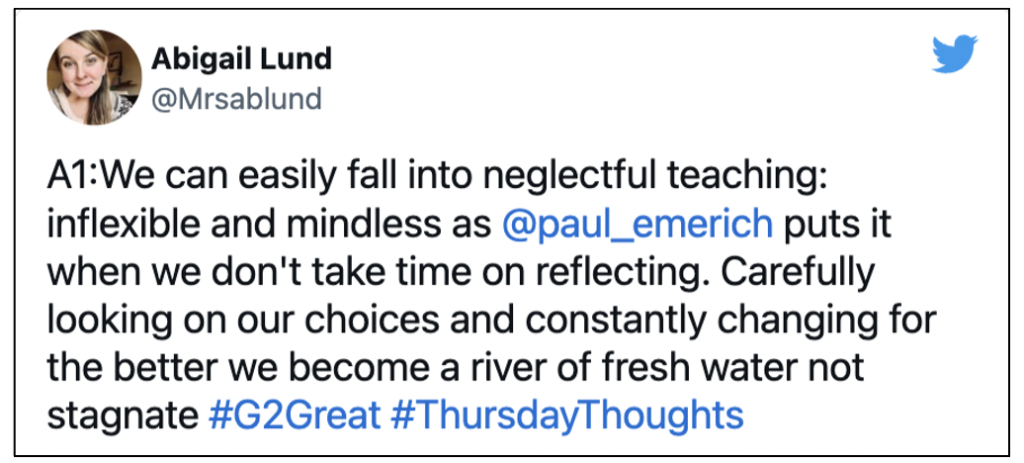

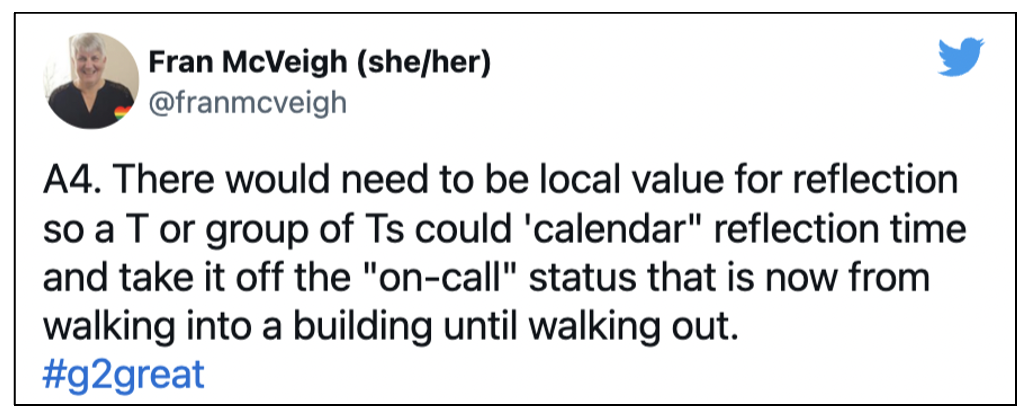
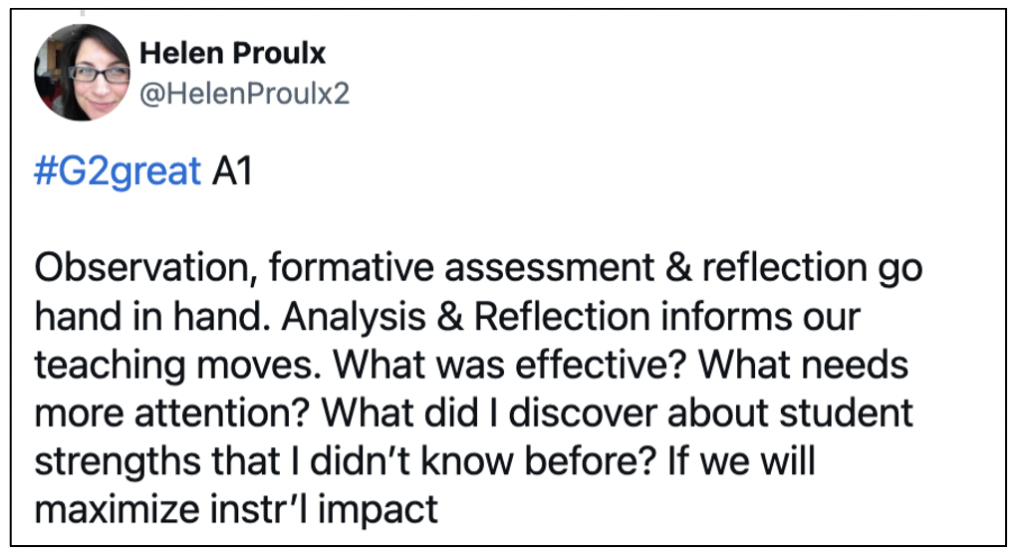
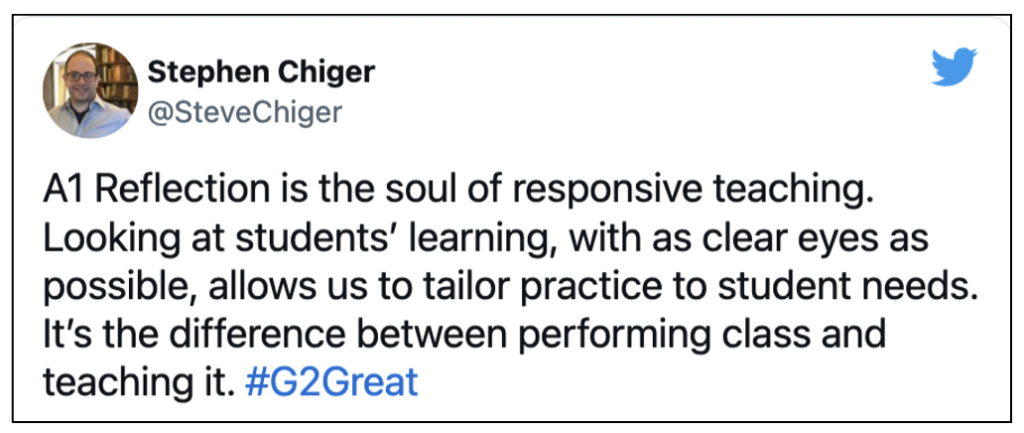
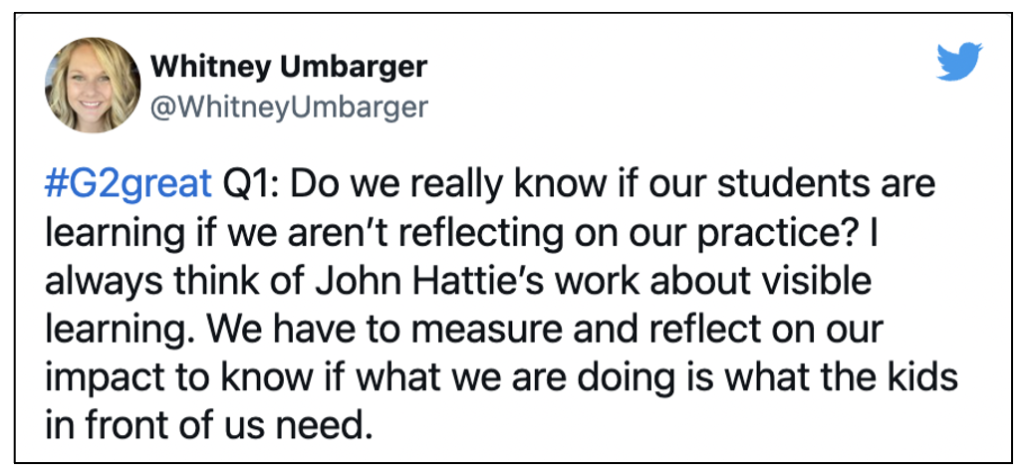
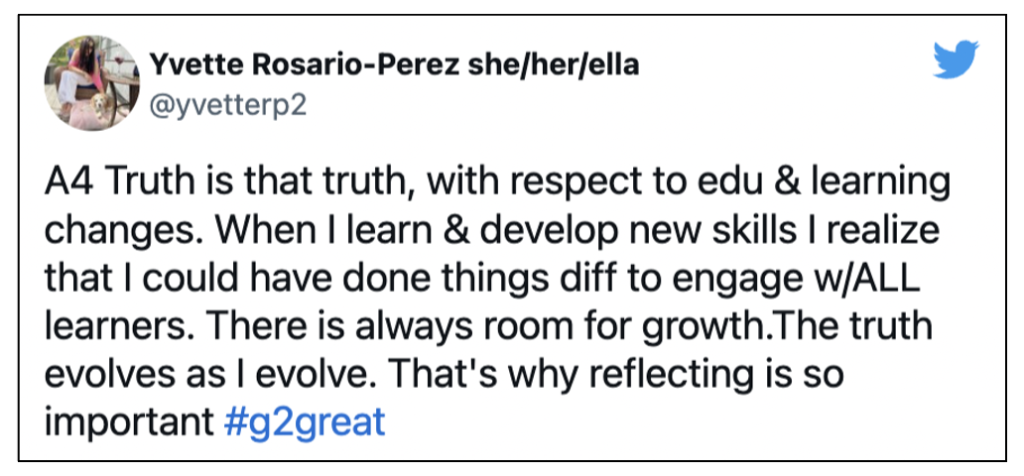
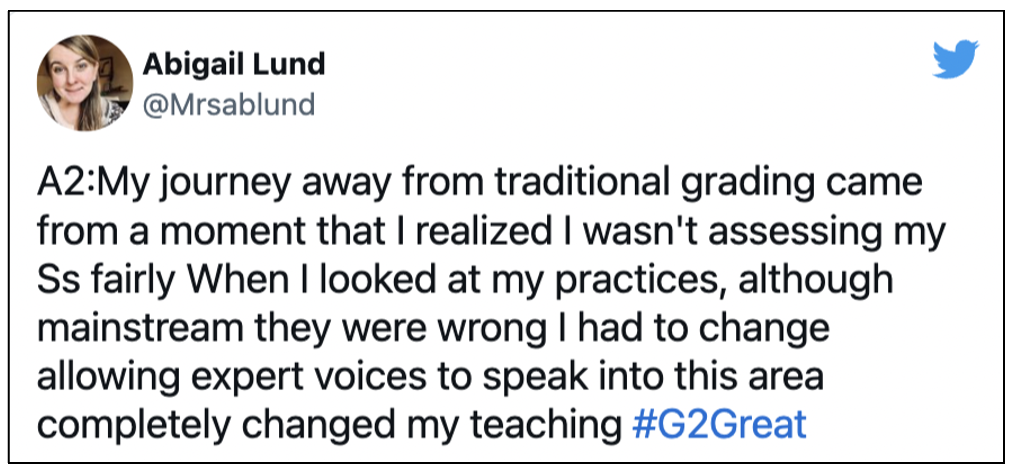
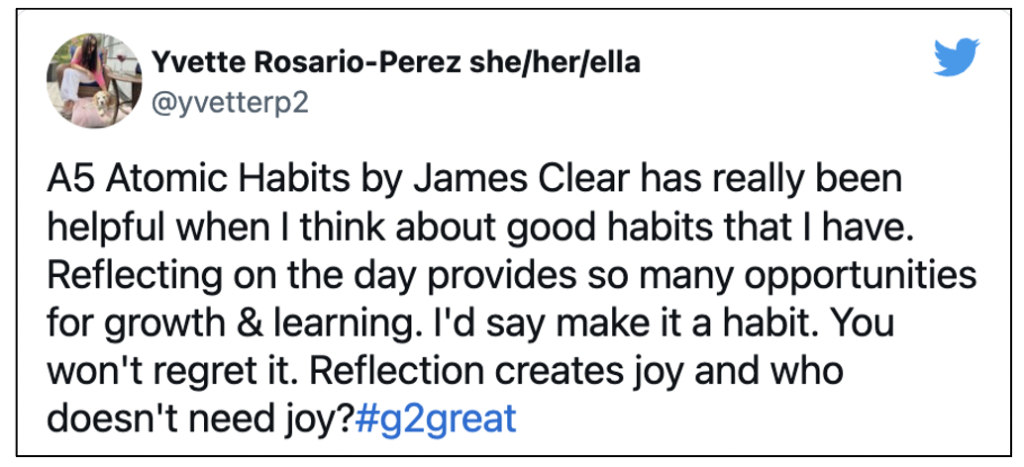
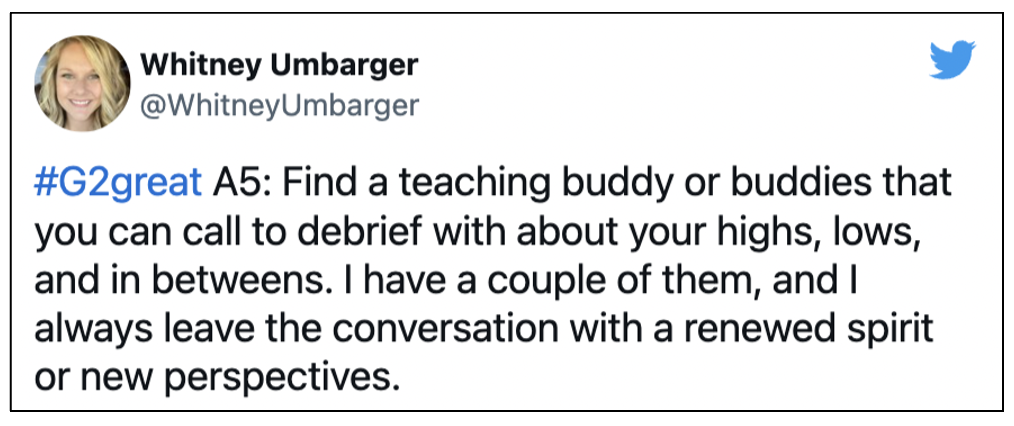
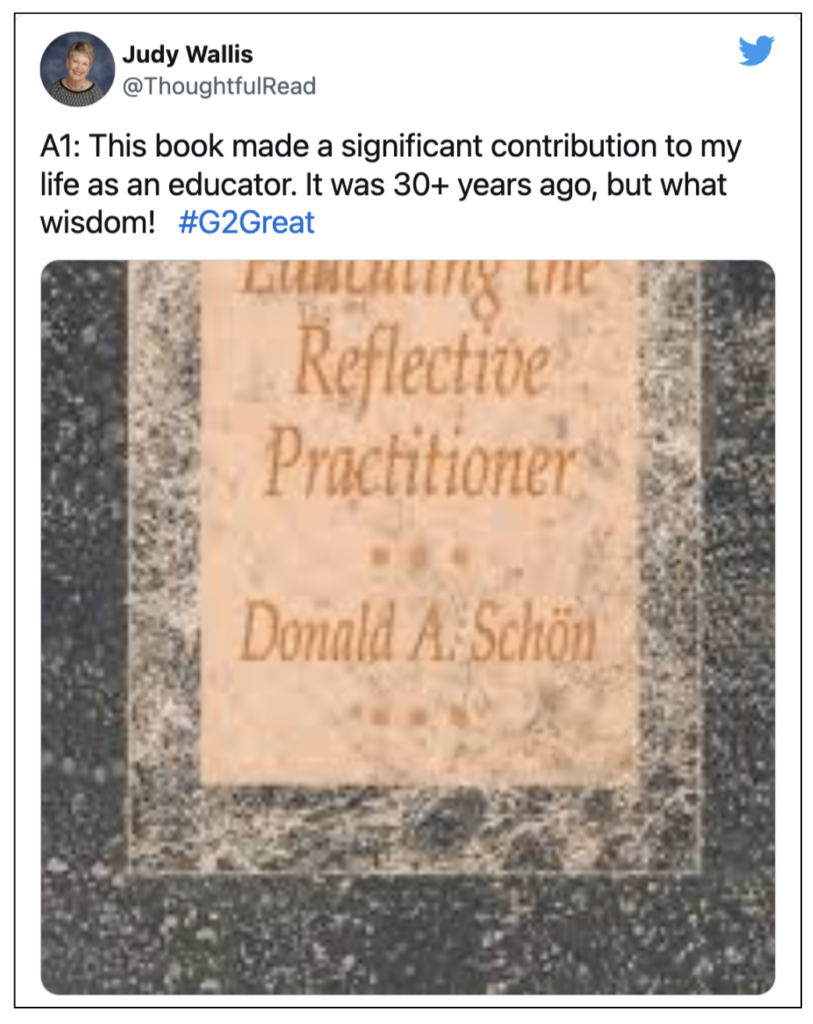
And so, just as I did in our first SLOW CHAT, I’ll close with a SLOW BLOG by sharing five twitter takeaways from our reflection chat that captivated my professional heart.
SLOW BLOG TWITTER TAKEAWAYS
- Reflection is a central feature of our professional practices but it requires that teachers possess a depth of understanding about the research support for this process to implement it effectively.
- Reflection is a multi-dimensional process that allows us to use our professional decision-making and students engaged in learning as a pathway to explore new understandings and apply that where it matters most.
- Reflection can take place in a wide range of ways but to be effective it must be an ongoing practice rather than a one-shot effort so that it becomes a part of the very fiber of how schools enhance our daily instruction.
- Reflection can occur in a wide range of ways but there is power in having other sets of eyes that comes alive when we collaborate with colleagues such as peer observation or video taping a lesson for discussion.
- Reflection can inspire us to initiate action research in order to use this process to document the impact on learning over time and analyze that for the sake of making far reaching changes in our teaching for years to come.
LAST THOUGHTS
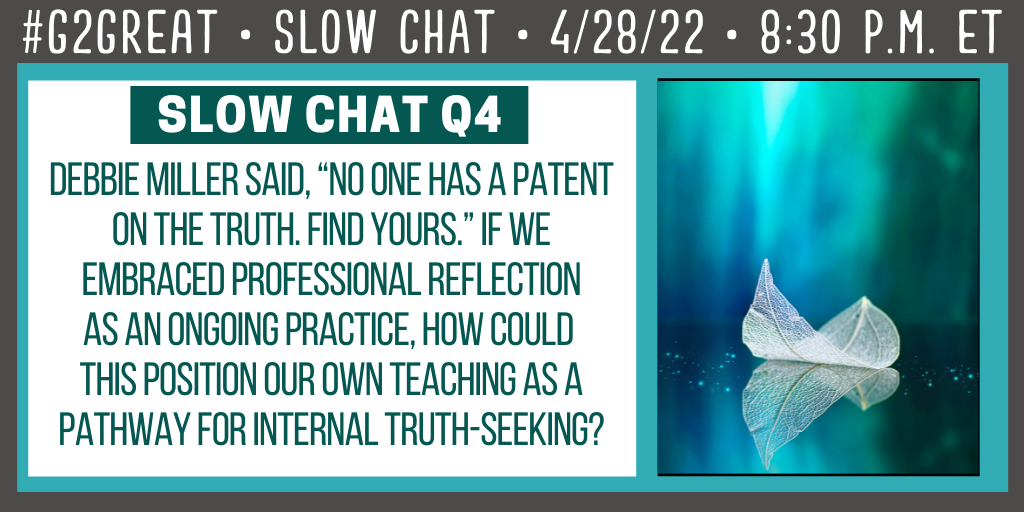
In a question shared during the chat, we included a powerful quote from Debbie Miller shown in the slide above that is a perfect closing point:
“No one has a patent on the truth. Find yours.”
As Debbie Miller said so eloquently, reflection allows us to position our own teaching as a pathway for internal truth seeking. This seems like a particularly relevant point that is particularly crucial as schools are seeking to mandate instructional compliance and there are growing groups that are forcing their own unsubstantiated truths upon the educational world. Add to that the never ending standardized testing that provides a numerical form of flawed truth that is equally unsubstantiated and we have a professional storm brewing as teacher empowerment is under attack. Teachers are understandably confused by these mixed messages that ask us to be compliant disseminators who blindly follow the lead of others. Teachers who are knowledgeable are rightfully resisting that push and pull between what we are obligated to do and what we know to do. They want desperately to hold tight to a decision-making role that is inherent in highly effective teaching. Reflection affords us a way to turn our teaching inward and gaze from new eyes based on our children and then use this to literally transform the day to day choices we make on their behalf…
And that my friends, is the best form of truth seeking I know.